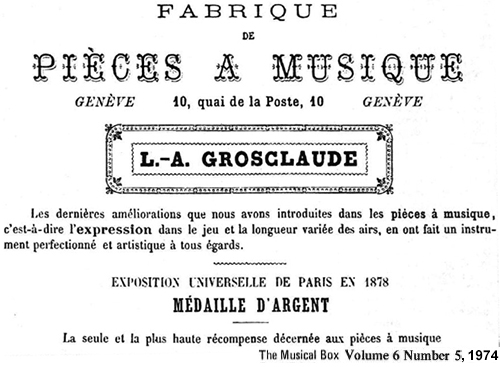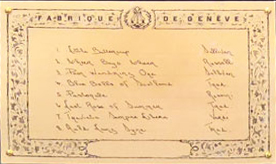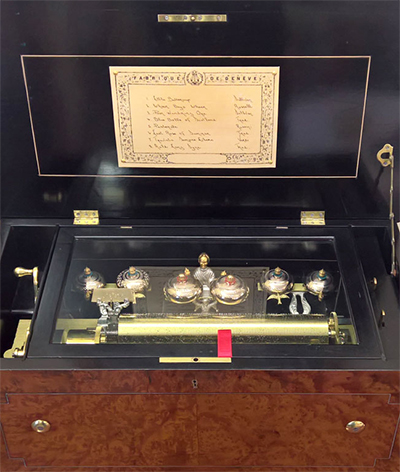|
Louis-Auguste Grosclaude (*1841, possibly from 1871 with associate Perrelet), maker from 1874 – 1880 (or later?), –?) Grosclaude is an important but lesser-known maker of clocks and musical boxes in Geneva in the 1870s was L. A. Grosclaude. One of his advertised addresses was 10, quai de la Poste, which is on the south bank of the Rone nearly opposite Billon et Isaac. […] The boxes by Grosclaude are so rare that one is driven to the assumption that a lot of his output must be among the multitude of „anonymous“ boxes. So far the only clue to his manufacture seems to be L. A. GROSCLAUDE, GENEVE stamped on the governor side-plate. This for example identifies a box in the Murtogh Guinness collection illustrated on page 171 of the MBSI Silver Anniversary Collection. It has drum, castanet, four bells struck by two mandarins, a reed organ and a wood pipe organ, and a singing bird, but no tune sheet. (Bulleid, Technology, 1994, p. 17-18) Perhaps the business continued after 1880 as nickel-plated movements are known with serial Nos. up to 40,000, not an easy total to reach in six or even nine years. (Bulleid, Technology, p. 1) Geneva. Louis Auguste Grosclaude was born in 1841, probably at Le Locle. He was associated with Auguste Perrelet from 1871 to 1874 under the name A. Perrelet et Cie. and from then to about 1880, he manufactured musical boxes on his own. After that, he spent nine years as a professor of algebra, geometry, astronomy and technical drawings at the École d´Horlogerie de Genève, founded in 1824. A maker of quality musical boxes who was awarded a silver medal at the International Exhibition in Paris [1878]. He also made tools for musical-box makers. Pierre Germain, who has researched Grosclaude, has traced four adresses: 5 rue du Mont Blanc; 16 rue Kléberg; 10 quai de la Poste; and 2 bis, rues Saint-Leger. See also Lecoultra, C. and Perrelet, Auguste. (Ord-Hume, Musical Boxes, p. 306)
Most makers made comparatively few „super“ boxes with bells, organs etc., among hundreds of more modest types. Possibly some makers were less concerned to stamp their names on their less exotic products, leaving a clear field for their agents. (Bulleid, Technology, p. 18)
Exposition universelle de 1878: Grosclaude was one of the three winners of the highest musical box award in the Exposition universelle de 1878 in Paris. Grosclaude exhibited two musical clocks and three musical boxes: An orchestral, a harp harmonique piccolo with tune selector, and a long-playing box (40 minutes) with tunes of different lengths. (Bulleid: Cylinder Musical Box Technology, 1994, p. 17-18)(Bulleid, Technology, p. 17-18)
Siehe unbedingt auch die Nummer die Nummer 40299 von Grosclaude Siehe auch Fabrique de pièces de musique Vincent Freemann Nr. 1158
|




